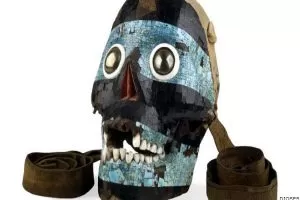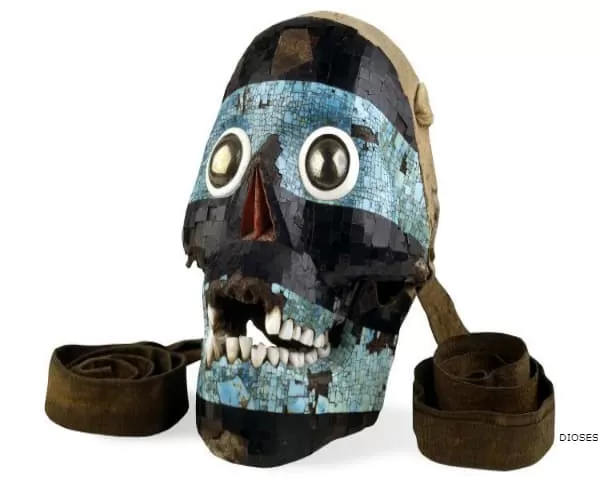Meaning of the God Tezcatlipoca
Tezcatlipoca (pron. Tez-ca-tli-po-ca)
Nahuatl: “Smoking Mirror” god of the constellation of the Great Bear and the night sky, one of the main deities of the Aztec pantheon.
He was known as Black Tezcatlipoca or the “mirror that smokes”, god of the day and of Texcoco. The mirror can mean that the god sees everything or governs all the earth, sometimes called smoking mirror. It is also known as Tezcatlipoca Azul, the “Hummingbird Sorcerer”, god of Tenochtitlan, where he was associated with the sun and the god of war Huitzilopochtli.
It could be known as Red Tezcatlipoca, the “Flayed”. Another manifestation of the god was as Tepeyolohtli, the jaguar god who lived in the center of the mountain of the earth. Always present, the god could intervene directly in human affairs to bring happiness and sadness.
Tezcatlipoca could have more sinister connotations when he was known as the Lord of Shadows or the Night, a sorcerer of black magic and the bearer of evil, death and destruction such as Chalchiuhtecólotl, “Precious Owl” or Chalchiuhtotolin, “Precious Turkey”.
Also associated with the conflict, he was known as Yaotl or “Enemy” and was the patron saint of warriors and their training camps (telpochcalli). However, he did not always protect the soldiers, as he could sometimes be found at a crossroads in the middle of the night, ready to challenge any confident warrior.
In a similar vein, Tezcatlipoca could represent those other unpleasant elements of the human condition: intense cold, sin and misery when he assumed the disguise of Itztlacoliuhqui. Finally, in a more positive role, when he was Omácatl, he was considered the patron saint of aristocracy and festivities. However, according to the complex character of the god of opposites in conflict, in this role he could represent both thieves and evil sorcerers.
Who is the God Tezcatlipoca ?
Tezcatlipoca was one of the most important gods of the Aztecs of central Mexico. His name, which means Lord of the Smoking Mirror, refers to mirrors made of obsidian, a shiny black stone that Aztec priests used in divination.
Tezcatlipoca played many contradictory roles in Aztec mythology. Like other Aztec deities, it could be useful and destructive. As a sun god, he matured crops but was also able to send a fiery drought that killed plants.
The patron god of defenseless people, such as orphans and slaves, was also the patron saint of royalty, and boasted in war and human sacrifice. Another of Tezcatlipoca’s roles was to punish sinners and cheats, but he could not be trusted.
Although associated with the sun, Tezcatlipoca was even more strongly associated with the night and its dark mysteries, including dreams, witchcraft, witches, and demons. Legend had it that he wandered the earth every night in the form of a skeleton whose ribs opened like doors. If a person met Tezcatlipoca and was bold enough to go through those doors and seize his heart, God promised him riches and power to be liberated. However, he would not keep his promises.
A mischievous and cheating figure who appears in various forms in folktales and in the mythology of many different peoples. As a cheating god, Tezcatlipoca delighted in reversing the order of things, causing conflict and confusion. Sometimes these interruptions could also be a source of creative energy and positive change.
Tezcatlipoca’s last trick was one he played with his companion god Quetzalcoatl. After presenting Quetzalcoatl to drunkenness and other vices, he used his mirror to show Quetzalcoatl how weak and degraded he had become. Quetzalcoatl fled ashamed of the world and left it to Tezcatlipoca. However, he promised to return at the end of a 52-year cycle.
What Attributes Does the God Tezcatlipoca Have ?
Tezcatlipoca was generally represented with a strip of black paint on his face and an obsidian mirror instead of one of his feet. The Maya-Quiché Post-Classical People
Tezcatlipoca was the tenth of the 13 lords of the day and associated with the horned owl in the Mesoamerican calendar, while its nagual or animal spirit was the jaguar. The Mexicas were associated with day 1: death and the god were worshipped especially during Tóxcatl, the sixth month of the 18-month solar year with those who worshipped the god who bore the epithet titlacauan, meaning “we are their slaves.
Perhaps it is indicative that, for better or worse, could not escape the attention and influence of Tezcatlipoca. The first representations of the god in art appear in the stone sculpture of Chichén Itzá in the Early Postclassic period (900-1200 AD). Here you can have a smoking mirror on your head and a snake instead of a foot, while in later descriptions of the god you have a polished black obsidian mirror instead of a left foot.
This foot replacement is a reference to a wound he received in his famous battle with Tlaltecuhtli during Creation. He is usually in the company of a turquoise snake, may have yellow and black stripes on his face and may wear a costume with corn designs (in reference to his role as god of the dry season and war) and skulls and bones (as he is a god of the underworld).
Sometimes he carries four arrows in his right hand, weapons he uses to punish evildoers. The god could be represented in different colors according to the cardinal point it represented: black for the north, blue for the south, red for the east and white for the west.
Tezcatlipoca is often represented with a turquoise mask with a black eye band. In fact, one of the most famous art objects of the god is the skull now decorated in the British Museum in London. The skull is covered in turquoise and black lignite mosaic with red spiny oyster shell in the nasal cavity. Polished pyrite surrounded by white snails provide the eyes.
The inside of the mask is lined with deerskin and the same material is used for the two straps that attach to the skull. This eye-catching object may well be one of the gifts that the Aztec king Montezuma II gave to Hernando Cortés in 1519 CE.
What is the Power of the God Tezcatlipoca ?
Invisible and omnipotent, he was known as a creator god, the god of sustenance, a patron of warriors and as the bearer of good and evil, he was the embodiment of change through conflict.
History of the God Tezcatlipoca
He was one of the most important gods in the Mesoamerican culture of the Post-Classic and a particularly important deity for the Toltecs (from the 10th century AD) and beyond. For the Aztecs, especially in Texcoco.
Often regarded as the supreme god, he assumed a bewildering variety of names and manifestations depending on where and by whom he was worshipped. The cult of Tezcatlipoca was brought to central Mexico by the Toltecs, northern Nahua-speaking warriors, in the late tenth century AD. Numerous myths relate how Tezcatlipoca expelled priest-king Quetzalcoatl, the Feathered Serpent, from the latter’s center in Tula.
A protein magician, Tezcatlipoca caused the death of many Toltecs by his black magic and induced the virtuous Quetzalcoatl to sin, drunkenness and carnal love, thus putting an end to the golden Toltec era. Under his influence, the practice of human sacrifice was introduced in central Mexico.
The nagual of Tezcatlipoca, or animal disguise, was the jaguar, whose stained skin was compared to the starry sky. A creator god, Tezcatlipoca ruled over Ocelotonatiuh (“Jaguar-Sun”), the first of the four worlds that were created and destroyed before the present universe.
After Guatemala’s 900th year he revered him as a lightning god under the name Hurakan (“One foot”). Other representations show Tezcatlipoca with his mirror on his chest. In it he saw everything; Invisible and omnipresent, he knew all the facts and thoughts of humans.
For Aztec times (XIV-XVI centuries), the multiple attributes and functions of Tezcatlipoca had taken him to the top of the divine hierarchy, where he ruled together with Huitzilopochtli, Tlaloc and Quetzalcóatl.
Called Yoalli Ehécatl (“Wind of the Night”), Yaotl (“Warrior”) and Telpochtli (“Young Man”), he was said to appear at a crossroads at night to challenge the warriors. He presided over telpochcalli (“young men’s houses”), district schools in which the children of ordinary people received elementary education and military training.
He was the protector of the severely punished slaves and teachers who mistreated the “beloved sons of Tezcatlipoca. He rewarded virtue by bestowing wealth and fame, and punished evildoers by sending them diseases (e.g., leprosy) or by reducing them to poverty and slavery.
Myths about the God Tezcatlipoca
One Creator God
Tezcatlipoca was believed to be the son of the primordial androgynous god Ometeotl. In Aztec mythology he was the brother of Quetzalcoatl, Huizilopochtli and Xipe Totec. In the complex myths of Mesoamerican creation, Tezcatlipoca ruled the first world of the Sun, but was overthrown by Quetzalcóatl.
The two later cooperated, however, to create the fifth sun. Transformed into giant snakes, the two gods attacked and dismembered the female reptilian monster known as Tlaltcuhtli (or Cipactli), one part became the earth and the other the sky.
Trees, plants and flowers sprouted from the hair and skin of the dead creature, while springs and caves were made with his eyes and nose and valleys and mountains came out of his mouth.
Mythical Adventures
In addition to Creation, Tezcatlipoca is involved in many mythical stories and one of the most curious is the arrival of the first dogs. The problem started with the old couple Tata and Nene, survivors of the flood that had previously destroyed the fourth world.
Finally, making earth, they stranded their boat of cypress logs and proceeded to make a fire by rubbing sticks. Then they decided to cook a fish, but the smoke from their fire disturbed the stars, especially Citlallatonac and Citlalicue.
These gods complained vociferously to Tezcatlipoca, who, perhaps a little harshly, cut off the couple’s heads and reattached them to their backs, so the first dogs were created.
Another story explains Tezcatlipoca’s association with music. One day, the god ordered a god of the black wind to go to the sun and look for music.
The wind god needed help for such a dangerous mission, so he recruited the assistants of Tezcatlipoca, a turtle, a mermaid and a whale, gathered them to form a bridge and cross the ocean.
The sun saw the god of wind arrive and warned his retinue of musicians not to respond to the demands that the wind might make, otherwise they would be sent back to earth with the wind.
However, the god of wind began to sing in such an irresistible way that one of the musicians felt compelled to respond, so he was punished by the sun and forced to return to earth, bringing with him the gift of music.
God’s love for music was also shown during the ceremony in Tóxcatl, where the imitator of Tezcatlipoca broke a flute at every step of the pyramid that climbed his way up to sacrifice.
Tezcatlipoca is a Wizard
Master sorcerer, he can also reveal real dreams and images in the smoking mirror.
According to legend, this mirror was polished in obsidian plate, the surface is disturbed by Tezcatlipoca’s will to reveal images near and far from the past, present or future.
I think it may be a technological object. Put an 11th century man in front of a flat screen, you’ll see a polished obsidian board. This is the natural material that most resembles a screen. And the wild has no other word to describe what it sees.
All the myths were narrated and deformed by wild generations who had no words for science or technology. Then they spoke of the magic of the gods. Any sufficiently advanced technology is indistinguishable from magic.
Sons of the God Tezcatlipoca
In the different stories there is no documentation of children of the God Tezcatlipoca
Temples of the God Tezcatlipoca
The main temple of Tezcatlipoca in Tenochtitlán was located south of the Great Temple. According to Fray Diego Durán, it was “elevated and magnificently built. Eighty steps led to a landing twelve or fourteen feet wide. Beyond it stood a wide, long chamber the size of a large hall.
There were several smaller temples dedicated to Tezcatlipoca in the city, among them the so-called “Tlacochcalco” and “Huitznahuatl”. Tezcatlipoca was also worshipped in many other Nahua cities such as Texcoco, Tlaxcala and Chalco. Each temple had a statue of the god for which copal incense was burned four times a day.
There were several priests dedicated to the service of Tezcatlipoca, one of them was probably what Sahagún called “huitznahuac teohua omacatl”, others were the calm teteucta who were allowed to eat the ritual food offered to Tezcatlipoca. Others accompanied the imitator Ixiptlatli of Tezcatlipoca in the year before his execution.
Tezcatlipocas’ parents were offered to his service by their parents when they were children, often because they were sick. These children would have their skin painted black and decorated with quail feathers in the image of the god.
The main ritual of the cult of Tezcatlipoca took place during Toxcatl, the fifth ritual month. Each year, at that time, the priest selected a handsome young prisoner of war.
For a year he lived in great luxury, personifying the god. Four beautiful girls dressed as goddesses were chosen as his companions. On the day of the appointed feast, she climbed the steps of a small temple while breaking the flutes she had played. In the upper part he was sacrificed for the extraction of his heart.
Outside the Aztec capital, Tenochtitlán, Tezcatlipoca was especially venerated in Texcoco and in the Mixteca-Puebla region between Oaxaca and Tlaxcala. In the month of Tóxcatl, the sixth month (or fifth) of the Aztec solar year, Tezcatlipoca was worshipped in special ceremonies.
As with other Aztec religious rites, an important part of the ceremony was the personification of the god, most often by a prisoner of war, who is usually the most attractive and bravest.
For a year before, in fact, the captive was tutored by priests, treated like a nobleman and even given four women to take care of him. These women pretended to be four goddesses: Atlatonan, Huixtocihuatl, Xilonen and Xochiquetzal.
When the special month finally arrived, the imitator was elegantly dressed in a warrior costume and at a symbolic wedding festival he married his four goddesses.
Honored with flowers and dances, the god-man was then moved to a dedicated temple where he was quickly sacrificed and his heart was withdrawn to honor the true Tezcatlipoca.
Related Topics
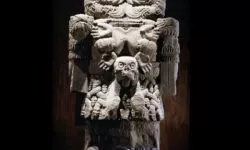
COATLICUE AZTEC GOD: The Serpent Skirt of the Aztec Pantheon
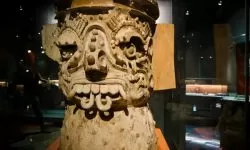
GOD TLÁLOC: Mayan of the Lightning and Rain of the Aztecs
Studies of Other Mythological Gods in ALPHAPEDIA
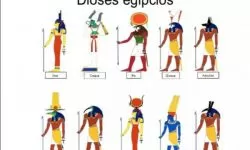
EGYPTIAN GODS: Their Names and Meanings
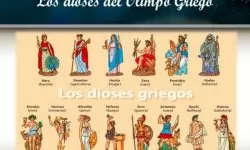
OLIMPUS GODS: ¿ Who Are ? ¿ What Are ? Names and Powers
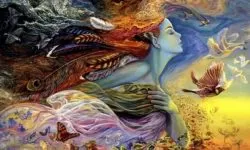
THE GODDESSES OF MYTHOLOGY: Their Names and Meanings
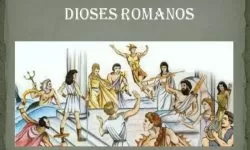
ROMAN GODS: Names, Meanings and Characteristics
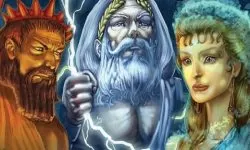
GREEK GODS: Names, Family Tree and Their Powers
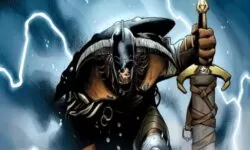
NORSE GODS: Names, Meaning, Powers and History
Other Topics of Interest in ALPHAPEDIA

FREE MASTER DEGREE IN COMPUTER SYSTEMS

FREE MASTER DEGREE IN ONCOLOGY

FREE BRAILLE COURSE

FREE MASTER DEGREE IN QUALITY AND PRODUCTIVITY

AQUAMARINE COLOR: Code and Meaning

FREE DIGITAL ILLUSTRATION COURSE
Images, Photos or Drawings of the Aztec God Tezcatlipoca
